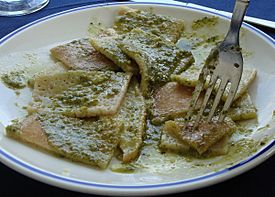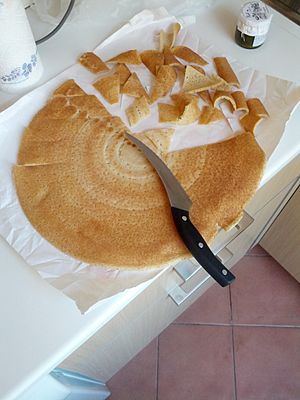Testaroli facts for kids

|
|
| Type | Pasta, bread |
|---|---|
| Place of origin | Etruscan civilization, Italy |
| Serving temperature | Hot |
| Main ingredients | Flour, water |
| Ingredients generally used | Salt |
| Variations | Falsi testaroli al ragù |
| Other information | May be served with pesto sauce, olive oil, Pecorino cheese, Parmigiano-Reggiano or garlic |
Testaroli is a special kind of pasta or bread from Italian cuisine. It's made from simple ingredients like water, flour, and salt. After cooking, it's cut into cool triangular shapes.
This dish is very popular in a part of Italy called Lunigiana. It's super old, coming from the Etruscan civilization in ancient Italy. Some people even say testaroli is "the earliest recorded pasta" ever! You can also find it in the southern Liguria and northern Tuscany regions of Italy.
Testaroli starts as a batter, like pancake mix. This batter is cooked on a hot, flat surface. Traditionally, it's cooked on a special tool called a testo. This is a flat cooking surface made of terra cotta or cast iron. The name testaroli actually comes from this testo! Sometimes, after being cooked on the testo, it's cooked again in boiling water before being served.
Testaroli can be thought of as a type of bread, a bit like focaccia. It's also sometimes compared to a crêpe. You can eat it with yummy pesto sauce, or other toppings like olive oil, Pecorino cheese, Parmigiano-Reggiano cheese, and garlic. There's also a similar dish called Falsi testaroli al ragù, which uses pasta dough and a meat sauce called ragù.
Contents
What's in a Name?
The name Testaroli comes from the word testo. A testo is a special cooking tool. It's a flat, hot surface made of terra cotta or cast iron. This is where testaroli is traditionally cooked.
A Taste of Ancient History
Testaroli is a very old pasta. It first came from the Etruscan civilization, which was an ancient group of people in Italy. One book says that testaroli is like the "great-grandchild" of porridges. These porridges were cooked by pouring them over hot stones way back in the Neolithic age (the New Stone Age).
This dish is native to the southern Liguria and northern Tuscany regions of Italy. An article in The Wall Street Journal even called it "the earliest recorded pasta."
In the Massa and Carrara province in Tuscany, testaroli used to be a simple meal for ordinary people. They would eat it as a single course, topped with grated cheese and olive oil. Sometimes, they added stracchino cheese or charcuterie (cured meats). Testaroli is still super popular in Pontremoli. This is a small city in Massa and Carrara. You can find it in almost every restaurant there, for both breakfast and dinner! It's also a common and special dish in the Lunigiana region of Italy. This area is located between the Liguria and Tuscany regions.
How is Testaroli Made?
Testaroli is a pancake-like pasta. It's made from water, wheat flour, and salt. Sometimes, chestnut flour is also used. All the ingredients are mixed to make a batter. Then, it's cooked. This cooking often happens in two steps.
Cooking Methods
In the first step, the batter is poured onto a hot, flat surface. It cooks like a pancake or a crêpe. Traditionally, this is done on a testo. The testo is heated over hot coals. You can also use a regular skillet to cook the batter. After cooking, the pasta is cut into triangles. Sometimes, it's served right after this first cooking step.
In the second cooking step, the pasta might be left to cool. Then, it's cooked again in boiling water.
Testaroli is sometimes called a type of bread, similar to focaccia. It's also compared to a crêpe. One book describes it as a "near cousin to pasta." It's like a "great round pancake-like bread" that's not very thick. If it's baked until it's crispy, you can eat it like bread. If it's baked less, it can be soft and spongy, like pasta. The ways of cooking testaroli can be different in various parts of Italy. Some of these methods are very old and traditional.
How to Serve Testaroli
Testaroli is often served with pesto sauce. Pesto is a very common topping in the Liguria and Tuscany regions. Other ways to dress it include adding olive oil, Pecorino cheese, Parmigiano-Reggiano cheese, garlic, and basil. Testaroli can soak up a lot of sauce, which makes it extra tasty!
Falsi Testaroli al Ragù
There's a very similar dish called falsi testaroli al ragù. This means "false testaroli in ragù" in English. This dish is made with sliced pasta dough. It doesn't use a batter or get cooked on a testo. Instead, it's served with a ragù, which is an Italian meat-based sauce.
See also
 In Spanish: Testaroli para niños
In Spanish: Testaroli para niños


